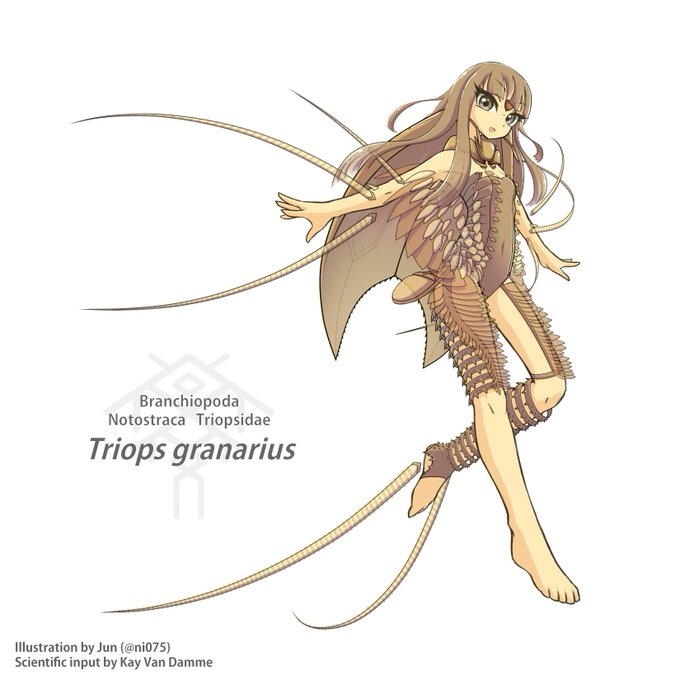arthroのTwitterイラスト検索結果。 1,048 件中 37ページ目
#Arthrogirls に限ればこの3人(436、403、269)。ゲジの子は同期の中でも出来に自信のない一枚なので伸びは予想もしていなかった。
#自分のTwitterいいねTOP3をあげる
Habelia are small predators that lived around the Cambrian period. Despite their chelicerate affinity, their functional morphology are more similar to those of mandibulates. Their anterior limb pairs, instead of walking, are more specialized for sensing and feeding.
#Arthrogirls
Remipedes (Remipedia) are blind, hermaphroditic crustaceans that restricted by underwater cave system. They are unusual for crustaceans in many ways, as they bore venom fangs, undivided trunk region, and genes which suggest that they are closely related to insects.
#Arthrogirls
Going to press on Monday, #Arthropedia is a personal alphabet of #invertebrates by @VannaBartlett1. #shieldbugs, #hoverflies, #moths, #bees, #beetles, #butterflies and more. @Swallowtailprin will be printing the book in Norwich. On sale in April, £20 in the UK.
Whip spiders (Amblypygi) are not but one of the close relatives of spiders, characterized by raptorial pedipalps and whip-like sensory legs. Contrary to their agility in predation, they are usually mild-tempered, with some species are even known to live in groups.
#Arthrogirls
Jumping spiders (Salticidae) are a speciose group of agile, free-living spiders that possess excellent eyesight for searching prey and courtship display. They can jump in an instant, but these are powered by the pressure of body fluid intsead of specialized muscles.
#Arthrogirls
Centipedes (Chilopoda) are predatory myriapods exist for more than 400 million years, united by a pair of venomous fangs which are in fact specialized front limbs. Contrary to their name which mean 'hundred-legged', they usually only have odd numbers for leg pairs.
#Arthrogirls
Woodlouse spiders (Dysdera crocata) are free-living spiders that prey on woodlouse. They have huge fangs, but instead for crushing, the spiders uses them for holding the woodlouse in place, injecting venom by stabbing one of them to the prey's unprotected underside.
#Arthrogirls
Snow flies (Chionea) are crane flies (Tipulomorpha) that active during winter, as their body fluid contain glycerol to prevent them from freezing. They are almost wingless, and the space which originally housed by flight muscles are instead use to store their eggs.
#Arthrogirls
Sea spiders (Pycnogonida) shared unsual body plan that their bodies are almost just legs, even their guts were branched and associated within each of them. They are not spiders nor even arachnids, instead they most likely arose from a very basal chelicerate lineage.
#Arthrogirls
Great blog post by @GlobalBiotic about our recent @NSF @iDigBio #parasitetracker meeting! The goal is to digitize arthropod parasites #lice #ticks #parasite #mite #mosquito
https://t.co/jXQaIPd075
Helping @VannaBartlett1 turn her illustrated alphabet of invertebrates into a beautiful book of #bugs. Last stages of putting it all together for publication in April. #Arthropedia has 112 pages packed full of info & pics. #insects #bees @Buzz_dont_tweet @Swallowtailprin
Tadpole shrimps (Notostraca, not shrimps) are branchiopod crustaceans that considered to be 'living fossils', and some extant species even have extensive fossil records. Adapted to temporal aquatic ecosystem, their resting eggs can survive long-lasting dry periods.
#Arthrogirls
Apochima juglansiaria are Geometer moths (Geometridae) that bore repeatedly folded wings. They only active during springtime, and their bird-dropping-like caterpillars will pupate long before summer, spending the remain seasons underground until spring comes again.
#Arthrogirls
Motyxia are millipedes that endemic to the moutain ranges of California, as well as one of the few millipedes that could glow. The bluish-green light of their exoskeleton are warning signals to nocturnal predators, as they contain secretions of toxic cyanide.
#Arthrogirls



































